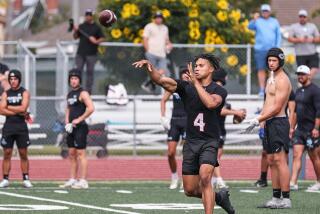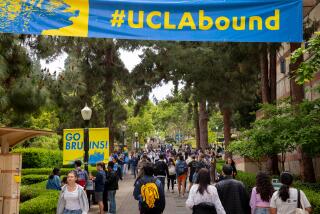Valley Interview : Mission College Closer to Its Niche at 20th Birthday, Leader Says
- Share via
With its 20th anniversary approaching in February, Mission College in Sylmar has come a long way from its humble beginnings in a collection San Fernando storefronts in 1975.
The campus, the youngest in the nine-campus Los Angeles Community College District, moved to its permanent 22.5-acre campus site in the fall of 1991. But with only a handful of permanent buildings and a site one-quarter of the size considered normal, it still has a long way to go toward becoming a full-fledged community college.
President Jack Fujimoto, 65, who began as a city schools teacher in 1959, arrived in 1989 to help spearhead the transition. Prospects for rapid growth and expansion dimmed when the college’s enrollment, at its peak more than 7,400 students in 1992, fell to fewer than 6,000 this fall, reflecting both statewide enrollment declines and the impact of the Northridge earthquake in January.
Fujimoto, who said he hopes to stay at the campus several more years, talked of how he has tried the steer the college into a closer relationship with the surrounding East Valley community.
*
Question: Give us an assessment of Mission College as it reaches its 20 - year anniversary.
Answer: Mission College has always been, at least in my mind, a free spirit where people try things. People do things, and even if you fail, nobody criticizes you for failing.
But what’s happening is we’re finding consolidation of facilities and people to the new campus, and that’s really a traumatic experience. It’s like bringing the family together and the facilities are too small for the big family. So now, three years later, people are saying, “20th anniversary.” But we’re sort of locked in.
Q: Does Mission have a different role from your sister colleges in being more outwardly directed to community involvement?
A: Yes. I’m taking it that way purposely, because my concept of a community college is it’s a college in a community, and we need to help the community develop. I see some of that from President Mary Lee at Pierce College. But I don’t see as much as we try to do. We’re in economic development activities, social development and community activities.
Q: Describe a couple of things the college is doing in those areas.
A: If we look at earthquake recovery, one of the first things that hit us was we lost about 1,000 students right off. But at the same time we were out in the community, counseling small business and community folks and helping them get loans from FEMA and SBA.
Another activity is what we call the Blythe Street project. What in essence happened in Blythe Street is Mission College opened a kitchen. We train immigrant vendors on the standards of good health and nutrition for them to sell their wares. In a community where we have gangs and poverty as problems, and immigrants as an issue, we’ve gone in and we’ve helped a population.
Q: What are some of Mission College’s main weaknesses at the moment?
A: I think one of the weaknesses has to be not being able to meet the needs of the people in the community as they’ve expressed them. For instance, the Sylmar residents’ group has complained so much about on-street parking, and students don’t park in the parking lots here because there aren’t enough parking spaces. Facilities are another problem. We don’t have large classrooms. We don’t have large offices.
Q: Is the content of the programs you offer here different from what you’re going to find at the other district campuses?
A: I think we’re much more non-traditional, meaning that because we don’t have a lot of faculty, many of them are going to teach day, evening, split programs, four-day weeks, Saturdays. And our classrooms are going at least six days a week. I don’t find that in the other colleges as much.
Also, we’re still a relatively young college. We borrow from the other colleges in terms of the courses and programs. What Mission College needs to do is find its own niche where it is going to do well. Yet at the same time, we don’t want to fall into the niche that says, “You’re a remedial school.” And we don’t want to be known as a Hispanic college only, either.
Q: Let’s talk about students. When students come to Mission, do they differ from those going to the other campuses in the district?
A: Those who go to Valley and Pierce colleges I think are much more the traditional college-bound student. The college-going rate of students around Mission College is much smaller. Many of the students who come here are the first ones in the family. And the family is mostly saying, “We have an economic struggle and you need to help us.”
Q: Traditionally, community colleges have several goals for their students: transfers to four-year institutions, vocational education, and basic skills such as remedial programs. How does Mission fit into those categories?
A: I don’t think Mission College has done well in terms of transfer. We’ve made significant progress in the time I’ve been here. But the numbers are very small. In terms of vocational certificates, we give a lot of certificates. But what we need to do is track those individuals to say, “What’s that particular certificate done for you?”
Q: What are students typically looking to accomplish when they are done at Mission College?
A: They want to transfer to the Cal State or University of California systems. They want that, but their expectations are a little higher than what their abilities are. So therefore they become tailored very quickly to a vocational goal. About 60% come in hoping to transfer, but it becomes about 60% certificate- or vocational-oriented.
Q: Why is there that divergence in the expectations of your students and their abilities?
A: Basically society’s values. I think as a parent I want my kid to go into something that’s going to produce some bucks for them, or at least a comfortable living. But the student may not have the same abilities, because whatever he learned up to this point isn’t going to get him there.
Q: Mission is third in the district in terms of its Latino student proportion. For incoming students, is the language issue something you have to deal with and how?
A: Many will be very strong in Spanish, and so in the initial contact, we have to have people who speak Spanish give them some guidance. But as time goes on, I think that pretty much starts to fall by the wayside because many of them pick up English-language skills very readily.
Q: There were some developments in the state budget this year as far as Mission’s plans for the future. Can you summarize what happened?
A: We were able to get about $4.5 million in the governor’s budget to start negotiating with the county for another 40 acres to expand into the adjoining golf course or El Cariso Regional Park. In the coming year, I see an educational master plan coming, an environmental impact report and a facilities master plan. And we can use those as a backdrop for the 20th anniversary.
Q: Do you have other plans for the future?
A: Mission College has roughly about 150 foreign students now. I’d want to expand that into about 500 foreign students to make us much more cosmopolitan. One of the things we don’t have is apartments. But if we start developing some kind of dormitory system or agreements with apartment owners, then that opens it up.
Q: Financially, you have a reputation as someone who goes out and tries to develop outside grant funding. Is Mission different from the other campuses in that regard and why?
A: Survival. Because we need the external funds. Budgets are based on full-time equivalent students. But the students who come here don’t take a lot of courses. They’re not the type that can manage 21 units or 24 units at a crack. So the number of full-time students is not that great. The only way we can keep on top of things is by going out and saying, “We’re the little kid on the block, we’re just growing up, we need a lot of money.”
More to Read
Sign up for Essential California
The most important California stories and recommendations in your inbox every morning.
You may occasionally receive promotional content from the Los Angeles Times.










